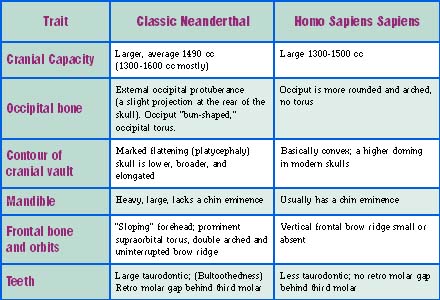Since the first Neanderthal fossil was discovered in the middle of the last century, their remains have been highly controversial. By the mid 1950s, some scientists were beginning to argue convincingly that Neanderthals are a sub species of modern humans (Homo sapiens) (Lewin, 1998), citing a wealth of evidence to support the view that Neanderthals were human.
Language
Some evolutionists have claimed that Neanderthals were incapable of modern speech, lacking the ability to produce the full range of vowels (Lieberman and Crelin, 1971; Trinkaus and Shipman, 1992), with flat non-flexing at the base of the skull, and the larynx positioned higher in the throat than in modern humans or even chimpanzees. The result of this computer reconstruction was that the resonating chamber at the back of the mouth was all but eliminated.
Many of these arguments have now been thoroughly refuted. A new and updated reconstruction done in 1989 by paleoanthropologist Jean-Louis Heim showed an essentially modern human flexation of the base of the skull (Trinkaus and Shipman, 1992; Shreeve, 1995). More recently, the La Chapelle skull was compared to a sample of modern human specimens from the middle ages and found to be quite human (Frayer, 1993).
In 1983 one of the most complete Neanderthal skeletons ever found was discovered at Kebara in the Levant, which included the first fossil hyoid bone of a Neanderthal ever discovered. This bone is located in the throat and is directly related to the structure of the human vocal tract and is indistinguishable from that of modern humans (Arensburg et al., 1987).
Neanderthal Brains
A Neanderthal brain volume equals or exceeds modern human dimensions (Deacon, 1994), ranging from about 1200_1750 ml, and thus on the average about 100 ml larger than modern humans (Stringer and Gamble, 1993). Holloway (1985: 320) has stated "I believe the Neanderthal brain was fully Homo, with no essential differences in its organization compared to our own."
Although there is no direct correlation between brain size and intelligence, Neanderthal brain volume certainly does not support views that argue for an evolutionary expansion of "Hominid" brains.
Neanderthal Anatomy
Neanderthal anatomy is essentially human in scope, with the same number of bones as humans, which function in the same manner (Trinkaus and Shipman, 1992). However, there are minor differences in robusticity (thickness and strength). These differences are trivial and can be found on an individual basis in modern living populations (Lewin, 1998). Although there is no formal agreement of which physical characteristics are diagnostic of Neanderthal morphology, a suite of traits have been used to distinguish Neanderthal morphology. Cranial traits are listed in the table below.
Still one may wonder why the entire suite of traits are not found in modern populations, but consider that Neanderthals typically lived in extremely cold climate areas, genetically isolated by a post-flood ice age. That would have directly affected their anatomy and physiology (Stringer and Gamble, 1993).
Two ecological rules describe the relationship between the size and the shape of the extremities (limbs) and trunk anatomy. Burgmann's rule regarding surface area postulates that body weight tends to be larger in cold climates. With two bodies of similar shape, the larger will have less surface area per unit of volume and will retain heat better in cold climates. Allen's rule suggests that body limbs will be shorter in cold climates, reducing surface area that results in less heat loss. This is seen in the short tails, ears, or beaks in many animals living in cold climates. Humans that live in cold climates, such as Eskimos, are typically larger with shorter arms and legs. Since Neanderthals lived in near arctic conditions in many cases, one would expect them to have a stocky body build and short extremities (arms and legs) (Holliday, 1997). In fact, the limbs of Neanderthals from the warmer climates of Southwest Asia are relatively longer than the limbs of those living in ice-age Europe. When Neanderthal limb proportions, based on a mean index of tibia/femur length, called Crural Index, are plotted against mean annual temperatures. Neanderthals appear to be even more cold-adapted in their limb proportions than modern Eskimos and Lapps (Stringer and Gamble 1993; Stringer and Mckie, 1996).
In addition, Neanderthals lived a life style that put rigorous demands on their bodies as seen from numerous skeletal lesions, many the result of traumatic bone breakage. (Trinkaus and Shipman, 1992.) Further, it has recently been suggested, based on intense dental study, that Neanderthals may have had a greater longevity than modern populations. This may have also affected their anatomy (Cuozzo, 1998).

Neanderthal Culture
There are a large number of cultural habits that distance Homo sapiens from animals. No other organisms, either living or fossil, made tools to make other complex tools, buried their dead, had controlled use of fire, practiced religious ceremonies, used complex syntax in their spoken grammar, and played musical instruments, yet we know from their fossils that Neanderthal engaged in all.
Deliberate burial of Neanderthal remains is well known from at least 36 sites with a geographical distribution over most of Eurasia (Gowlett, 1994), with at least 20 complete skeletons known (Lewin, 1998). Some graves have stone tools, animal bones, and flowers buried in the ground, along with the Neanderthal remains. At the Uzbekistan Neanderthal site of Teshik-Tash, is a boy's grave surrounded by a ring of mountain goat bones, horns, and levallois tools indicating ritualism of some sort. Burial is known to have occurred in an unnatural posture, which demonstrates that a corpse was not simply dropped into a hole in the earth without preparation (Trinkaus and Shipman, 1992). Burial implies an awareness of the after life and demonstrates the existence of formal ritual. Indication of strong social ties can be inferred from cases where Neanderthal individuals with severe crippling injuries were cared for (i.e., the Shanidar remains).
In 1996, pristine evidence of Neanderthal humanness came to light, when a cave in Slovenia produced a small flute made from the thigh bone of a cave bear. Four precisely aligned holes are punctured on one side of the four-inch-long bone (Folger and Menon, 1997). Thus cultural evidence strongly supports Neanderthal humanness.
Neanderthal (mitochondrial) DNA
The recent recovery of mitochondrial DNA from the right humerus of the Neanderthal remains from Neander Valley near Dusseldorf, Germany, has been of great interest to evolutionists and creationists alike (Krings et al., 1997).
Based on the comparison of modern human mt DNA and that taken from the Neanderthal, evolutionists have argued that the "Neanderthal line" diverged from the line of "hominids" leading to modern humans about 600,000 years B.P. without contributing mt DNA to modern Homo sapiens populations. This strongly implies that Neanderthals were a different species from modern humans.
However, the above noted interpretation is not scientifically justified. Lubenow (1998) has pointed out that the use of a statistical average of a large modern human sample (994 sequences from 1669 modern humans) compared with the mt DNA sequence from one Neanderthal is not appropriate. Furthermore, the mt DNA sequence differences among modern humans range from 1 to 24 substitutions, with an average of eight substitutions, whereas, the mt DNA sequence differences between modern man and the Neanderthal specimen range from 22 to 36 substitutions, placing Neanderthals, at worst, on the fringes of the modern range.
Conclusion
Neanderthals were human. They buried their dead, used tools, had a complex social structure, employed language, and played musical instruments. Neanderthal anatomy differences are extremely minor and can be for the most part explained as a result of a genetically isolated people that lived a rigorous life in a harsh, cold climate.
References
- Arensburg, B. et al., 1989. A middle Paleolithic human hyoid bone. Nature, vol. 338:758-60.
- Cuozzo, J. 1998. Buried Alive: The Startling Truth About Neanderthal Man. Master Books.
- Deacon, T. 1994. The Human Brain. In: Jones, S. R. Martin, D. Pilbeam, (ed.) The Cambridge Encyclopedia of Human Evolution. Cambridge University Press.
- Folger, T., and S. Menon. 1997 . . . Or Much Like Us? Discover, The Top 100 Science Stories (1996).
- Frayer, D. 1993. On Neanderthal Crania and Speech: "Response to Lieberman." Current Anthropology 34:721.
- Gowlett, J. 1994. Early human mental abilities. In: Jones, S and R Martin, D Pilbeam, (ed.) Ancestors: The Hard Evidence. New York: Alan R Liss Inc.
- Holliday, T. 1997, Postcranial evidence of cold adaptation in European Neanderthals. American Journal of Physical Anthropology 104:245-58.
- Krings, M et al. 1997. Neanderthal DNA sequences and the origin of modern humans. Cell 90:19-30.
- Lewin, R. 1998. The Origin of Modern Humans. Scientific American Library.
- Lieberman, P. 1984. The Biology and Evolution of Language. Cambridge, Mass., Harvard University Press.
- Lieberman, P. 1989. The Origin of Some Aspects of Human Language and Cognition. In: P. Mellars and C. Stringer (eds.), The Human Revolution. pp. 391-414. Edinburgh University Press.
- Lieberman, P. and E. Crelin, 1971. On the Speech of Neanderthal. Linguistic Inquiry, 2:203-222. Mayfield Publishing Company.
- Lubenow, M. 1998. Recovery of Neanderthal mt DNA: An Evaluation. Creation Ex Nihilo, Technical Journal, vol. 12(1) pp. 87-97.
- Shreeve, J. 1995. The Neanderthal Enigma. Solving the Mystery of Modern Human Origins. William Morrow and Company, Inc.
- Stringer, C. and C. Gamble 1993. In Search of the Neanderthals. Thames and Hudson.
- Stringer, C. and R. Makie 1996. African Exodus: The Origin of Modern Humanity. Hold and Co. New York.
- Trinkaus, E., and P. Shipman 1992. The Neanderthals: Changing the Images of Mankind. Alfred A. Knophf, New York.
- Wolpoff, M. and R. Caspari. 1997. Race and Human Evolution: A Fatal Attraction. Westview Press.
* Dave Phillips earned the M.S. in physical anthropology from California State University, Northridge, in 1991 and is now working on his Ph.D. in paleontology.
Cite this article: Phillips, D. 2000. Neanderthals Are Still Human! Acts & Facts. 29 (5).















